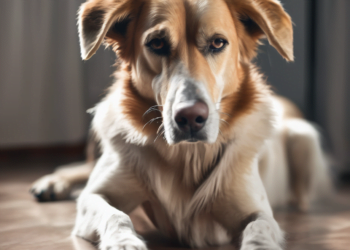In this comprehensive Labrador Retriever guide, you will find essential information on caring for your Labrador, including expert tips on training, grooming, health issues, and behavior characteristics. Whether you’re a first-time Labrador owner or a seasoned pet parent, this guide will equip you with the knowledge and guidance you need to provide the best care for your furry friend.
Key Takeaways:
- Labrador Retrievers are known for their friendly temperament and suitability as family pets.
- Proper care, including feeding, exercise, and regular veterinary check-ups, is crucial for their overall well-being.
- Training Labrador Retrievers requires consistency, positive reinforcement, and socialization from an early age.
- Common health issues in Labradors include hip dysplasia, obesity, and eye disorders, which can be managed with preventive measures.
- Regular grooming, such as brushing, bathing, and nail trimming, helps maintain their coat and hygiene.
Understanding the Labrador Retriever Breed
When it comes to dogs, the Labrador Retriever is in a league of its own. Known for their friendly disposition, intelligence, and versatility, these dogs have captured the hearts of families around the world. Understanding the history, origin, and unique characteristics of the Labrador Retriever breed can help you appreciate the exceptional qualities that make them such beloved pets. Originating in Newfoundland, Canada, Labrador Retrievers were initially bred as working dogs, assisting fishermen in retrieving nets and fish from the icy waters. Their natural affinity for water, combined with their exceptional retrieving instinct, made them invaluable companions for fishermen. Over time, Labradors gained recognition for their exceptional trainability, calm demeanor, and gentle nature. Their versatility and adaptability also made them popular as assistance dogs, search and rescue dogs, and therapy dogs. Today, Labrador Retrievers are cherished as family pets, excelling in various roles while providing endless love and loyalty. Labrador Retrievers are renowned for their friendly and outgoing temperament. They have a natural affinity for people and are known to get along well with children, other pets, and even strangers. Their sociable nature makes them excellent companions for families of all sizes and ages. One of the key characteristics that sets Labradors apart is their high intelligence. They are quick learners and eager to please, making them highly trainable. Labradors excel in obedience training, agility, and other dog sports, thanks to their sharp minds and natural athleticism. As a family pet, Labrador Retrievers thrive on human companionship and require plenty of love, attention, and exercise to keep them happy and healthy. They have boundless energy and need regular physical and mental stimulation to prevent boredom and destructive behavior.
Labrador Retriever Characteristics:
- Friendly and sociable
- Highly intelligent and trainable
- Adaptable to various roles and environments
- Eager to please
- An abundance of energy
- Requires regular exercise and mental stimulation
- Great with families and other pets
By understanding the Labrador Retriever breed’s history, temperament, and unique qualities, you can provide the best care, training, and companionship for your beloved Labrador Retriever.
| Labrador Retriever Breed Information | |
|---|---|
| Origin | Newfoundland, Canada |
| Size | Medium to large |
| Life Span | 10-12 years |
| Temperament | Friendly, intelligent, sociable |
| Recommended for | Families, active individuals |
Labrador Retriever Care Tips
Proper care is essential to ensure the overall health and happiness of your Labrador Retriever. Here are some important tips to keep in mind:
Feeding
A nutritious diet is vital for your Labrador’s well-being. Feed them high-quality dog food that is specifically formulated for their breed and age. Follow feeding guidelines provided by your veterinarian and monitor your dog’s weight to prevent obesity. Divide their meals into two or three portions a day to aid digestion.
Exercise
Labradors are energetic dogs that require regular exercise to stay physically and mentally stimulated. Plan daily activities like walks, play sessions, and interactive games to keep your dog active and prevent boredom. Engage them in activities such as swimming or fetch, as Labradors love water and retrieving.
Vaccinations
Stay up to date with your Labrador’s vaccinations to protect them from common canine diseases. Consult your veterinarian and follow their recommended vaccination schedule. Vaccinations typically include protection against distemper, parvovirus, rabies, and other infectious diseases.
Regular Veterinary Check-ups
Schedule regular veterinary check-ups for your Labrador Retriever to ensure early detection of any health issues and maintain their overall well-being. During these visits, your veterinarian will conduct a physical examination, administer vaccines, perform preventive treatments (such as heartworm prevention), and address any concerns you may have.
Taking care of your Labrador Retriever requires attention to their nutritional needs, regular exercise, vaccinations, and veterinary check-ups. By providing proper care, you can promote their health and ensure a long and happy life for your furry companion.
| Labrador Retriever Care Tips | Description |
|---|---|
| Feeding | Provide a balanced diet of high-quality dog food and feed in divided portions to maintain a healthy weight. |
| Exercise | Engage in regular physical activities, such as walks and play sessions, to keep your Labrador active and mentally stimulated. |
| Vaccinations | Stay up to date with vaccinations to protect your Labrador from common canine diseases. |
| Regular Veterinary Check-ups | Schedule routine check-ups with your veterinarian to monitor your Labrador’s health. |
Training Your Labrador Retriever
In order to have a well-behaved and obedient Labrador Retriever, proper training is essential. Whether you’re a first-time dog owner or have experience with other breeds, Labrador Retriever training tips can help you establish a strong bond with your furry companion and ensure a harmonious living environment. Training your Labrador Retriever should begin as early as possible to set the foundation for good behavior. Start with basic obedience commands such as sit, stay, come, and lie down. These commands not only make your dog more manageable but also keep them safe in different situations, like when crossing the road or meeting new people. Socialization is another crucial aspect of Labrador Retriever training. Exposing your dog to various environments, people, and animals at an early age will help them develop good manners and confidence. Introduce your Labrador to different sights, sounds, and experiences, gradually increasing the level of difficulty to prevent fear or anxiety.
Remember, consistency is key when training a Labrador Retriever. Set clear rules and boundaries from the start and stick to them. Use positive reinforcement techniques like treats, praise, and rewards to motivate your dog and reinforce desired behaviors. Avoid punishment-based training methods as they can lead to fear or aggression.
Labrador Retrievers are known for their intelligence and eagerness to please, making them highly trainable. However, they can also be prone to certain behavior challenges such as excessive chewing, jumping, or pulling on the leash. Addressing these issues requires patience, consistency, and understanding. To curb chewing behavior, provide your Labrador Retriever with appropriate chew toys and redirect their attention whenever they start biting on household objects. Teaching the “leave it” command can also be helpful in preventing unwanted chewing habits. If your Labrador tends to jump on people as a way of greeting, practice the “off” command and reward them for keeping all four feet on the ground. Consistency is vital, as allowing jumping in some instances and discouraging it in others can confuse your dog. Leash pulling can be a common challenge for Labrador Retrievers during walks. Train your dog to walk calmly on a loose leash by using rewards for good behavior and stopping or changing direction when they pull. Patience and a gradual approach are necessary to establish proper leash manners.
Labrador Retriever Training Tips Recap:
- Start training early with basic obedience commands like sit, stay, come, and lie down.
- Socialize your Labrador Retriever from a young age to develop good manners and confidence.
- Use positive reinforcement methods such as treats, praise, and rewards.
- Address behavior challenges like chewing, jumping, and leash pulling with consistency and patience.
| Training Tips | Description |
|---|---|
| Start Early | Begin training your Labrador Retriever as soon as possible to establish good behavior habits. |
| Positive Reinforcement | Reward desired behaviors with treats, praise, and rewards to motivate your dog. |
| Consistency | Set clear rules and boundaries and stick to them to avoid confusion for your Labrador. |
| Socialization | Expose your Labrador to various people, animals, and environments for a well-rounded temperament. |
| Address Behavior Challenges | Tackle common challenges like chewing, jumping, and leash pulling with patience and training techniques. |
Health Issues in Labrador Retrievers
Labrador Retrievers are generally a healthy and robust breed. However, like any other dog breed, they can be prone to certain health issues. Being knowledgeable about these common health problems allows you to take proactive measures to prevent them or manage them effectively.
Hip Dysplasia
Hip dysplasia is a genetic condition that affects the hip joints of dogs, including Labrador Retrievers. It occurs when the hip joints don’t develop properly, leading to hip joint instability and degeneration over time. This condition can cause pain, lameness, and difficulty in moving.
Obesity
Obesity is a significant concern for Labrador Retrievers due to their love for food. Being overweight puts a strain on their joints and can lead to various health problems, including joint issues, diabetes, and heart disease. Maintaining a healthy diet, portion control, and regular exercise are essential in preventing obesity in Labs.
Eye Disorders
Labrador Retrievers are susceptible to various eye disorders such as cataracts, progressive retinal atrophy (PRA), and glaucoma. These conditions can impair vision and, if left untreated, lead to blindness. Routine eye exams, proper nutrition, and prompt veterinary care are crucial in preserving your Labrador’s visual health.
“Some health issues in Labrador Retrievers can be genetic, while others are a result of lifestyle factors such as diet and exercise. By staying informed and proactive, you can ensure a healthier and happier life for your Labrador.”
Regular veterinary check-ups and preventive care, along with a balanced diet, exercise, and a safe environment, are key to maintaining your Labrador Retriever’s overall well-being. As a responsible pet owner, it is important to understand and address any health issues promptly, allowing your loyal Lab to live a long, active, and fulfilling life.
Grooming Your Labrador Retriever
Proper grooming is essential to keep your Labrador Retriever looking and feeling their best. Regular grooming sessions not only maintain their coat’s health but also help prevent matting, skin issues, and other hygiene problems. Here’s a guide to the essential grooming routine for your Labrador Retriever.
Brushing
Labrador Retrievers have a double coat consisting of a dense, weather-resistant outer coat and a soft, insulating undercoat. Regular brushing helps remove loose hair, prevents tangles, and promotes good circulation. Use a slicker brush or a deshedding tool to brush your Labrador’s coat at least once a week. Focus on raking through the dense undercoat to remove loose hair. This is especially important during shedding seasons to minimize shedding in your home.
Bathing
Bathing is necessary to keep your Labrador’s coat clean and free from dirt, debris, and odor. However, frequent bathing can strip their coat of natural oils, leading to dryness and skin irritation. Aim to bathe your Labrador Retriever every 8-12 weeks or as needed. When bathing your Lab, use a dog-specific shampoo and conditioner formulated for their coat and skin type. Rinse the coat thoroughly to remove all traces of shampoo and dry them completely to prevent moisture-related skin issues.
Nail Trimming
Regular nail trimming is essential for your Labrador Retriever’s comfort and health. Overgrown nails can cause discomfort, affect their gait, and even lead to joint problems. Trim your Lab’s nails every 2-4 weeks, or as needed, using a dog nail clipper or grinder. Take care to avoid cutting the quick, which is a sensitive area that supplies blood to the nails. If you’re unsure, consult a professional groomer or veterinarian for guidance.
Ear Cleaning
Labrador Retrievers are prone to ear infections due to their floppy ears and retained moisture. Regular ear cleaning helps prevent infections and keeps their ears healthy. Gently clean your Labrador’s ears once a week using a dog-specific ear cleaner and cotton balls or pads. Avoid going too deep into the ear canal and never use cotton swabs, as they can push debris further into the ear.
| Grooming Step | Frequency |
|---|---|
| Brushing | At least once a week |
| Bathing | Every 8-12 weeks or as needed |
| Nail Trimming | Every 2-4 weeks or as needed |
| Ear Cleaning | Once a week |
Understanding Labrador Retriever Behavior
Labrador Retrievers are renowned for their friendly and sociable nature. Their behavior characteristics make them beloved family pets and popular choices for various roles, including therapy dogs, search and rescue, and assistance work. To fully understand and manage your Labrador’s behavior, it is important to explore their innate traits and potential challenges they may face. 1. Friendly and Affectionate: Labradors are known for their friendly and affectionate nature. They have a natural affinity for people and are typically good with children and other pets. Their eagerness to please makes them highly trainable and adaptable to different environments. 2. Love for Retrieving: Labrador Retrievers have an instinctive love for retrieving objects. This behavior stems from their origins as working dogs with a strong desire to assist their owners. Engaging Labrador Retrievers in regular play and exercise that involves retrieving can help channel their energy and fulfill their natural instincts. 3. Potential Challenges: Like any breed, Labrador Retrievers may face certain behavioral challenges that require attention and management. Common concerns include:
- Chewing: Labradors have a tendency to chew, especially when they are teething or bored. Providing appropriate chew toys and regular exercise can help redirect their chewing behavior.
- Separation Anxiety: Labradors thrive on companionship, and being left alone for extended periods can lead to separation anxiety. Gradual training, crate training, and providing mental stimulation can help alleviate this challenge.
To effectively address these challenges and ensure a well-behaved Labrador Retriever, consider the following strategies:
- Early Socialization: Expose your Labrador to various people, animals, and environments during their early development stages to promote positive social behavior.
- Positive Reinforcement Training: Use reward-based training methods to reinforce desired behaviors and discourage unwanted ones. Labrador Retrievers respond well to positive reinforcement, such as treats, praise, and play.
- Consistent Exercise: Regular exercise is crucial for a Labrador’s physical and mental well-being. Providing ample opportunities for play, walks, and mental stimulation can help prevent behavioral problems resulting from boredom or excess energy.
Tips for Managing Labrador Retrievers’ Behavior Challenges
If you are facing specific behavior challenges with your Labrador Retriever, consider these practical tips:
“Labradors are highly trainable, and positive reinforcement works wonders with this breed. Be patient, consistent, and incorporate plenty of mental stimulation and exercise into their routine. Remember, a well-exercised and mentally stimulated Labrador is a happy and well-behaved one.”
| Behavioral Challenge | Management Strategy |
|---|---|
| Chewing | Provide appropriate chew toys, redirect their attention, and ensure they have enough physical and mental stimulation. |
| Separation Anxiety | Gradually train your Labrador to be comfortable being alone, use crate training, and provide engaging toys or puzzle feeders to keep them occupied. |
Finding the Best Labrador Retriever Breeders and Puppies for Sale
When searching for a Labrador Retriever puppy, it’s crucial to find a reputable breeder who prioritizes the health and well-being of their dogs. By choosing a responsible breeder, you can ensure that you are bringing home a happy and healthy Labrador companion. Here are some essential tips to help you find the best Labrador Retriever breeders and puppies for sale.
1. Do Your Research
Start by conducting thorough research on different Labrador Retriever breeders in your area. Look for breeders who have a good reputation and positive reviews from past customers. Check if they are registered with reputable kennel clubs or breed organizations, as this demonstrates their commitment to breed standards and responsible breeding practices.
2. Visit the Breeder
Once you have identified potential breeders, schedule a visit to their facility. Take the opportunity to meet the breeder in person, observe the living conditions of the dogs, and interact with the puppies and their parents. A reputable breeder will be open and transparent, willingly answering any questions you may have.
3. Health Testing
Inquire about the health testing performed on the breeding dogs. Responsible breeders will conduct tests for genetic disorders commonly found in Labradors, such as hip and elbow dysplasia, eye conditions, and exercise-induced collapse. Make sure the breeder provides you with the necessary certifications and documentation to verify the health of the puppies.
4. Socialization and Training
Ask the breeder about their socialization and training practices for the puppies. A reputable breeder will expose the puppies to various environments, sounds, and stimuli from an early age, ensuring they are well-adjusted and ready for their new homes. Look for breeders who start basic training with the puppies, setting a foundation for ongoing obedience and manners.
5. Contract and Guarantee
Obtain a written contract from the breeder that outlines all the details of the purchase, including health guarantees, return policies, and any restrictions on breeding or showing the puppy. A reputable breeder will always provide a contract to protect both the buyer and the dog.
“Choosing a Labrador Retriever breeder is an important decision that will have a long-lasting impact on your relationship with your four-legged companion. Take the time to find a breeder who prioritizes the health and well-being of their dogs, and you’ll be rewarded with a loving and loyal Labrador for many years to come.”
Checklist for Choosing a Labrador Retriever Breeder
| Criteria | What to Look for |
|---|---|
| Reputation | Positive reviews and recommendations, registered with kennel clubs or breed organizations |
| Facility Conditions | Clean, well-maintained living conditions for dogs |
| Health Testing | Testing for genetic disorders like hip dysplasia, eye conditions, and exercise-induced collapse |
| Socialization and Training | Early exposure to various environments and basic training |
| Contract and Guarantee | Written contract outlining details of the purchase |
By following these guidelines and taking the time to find a reputable breeder, you can ensure that you bring home a Labrador Retriever puppy that is well-bred, healthy, and ready to become a cherished member of your family.
Conclusion
This comprehensive Labrador Retriever guide equips you with all the necessary information to provide optimal care, effective training, and a deep understanding of your beloved Labrador Retriever. By following the expert tips and guidance provided throughout the guide, you can cultivate a strong bond with your Lab and ensure a happy, healthy life for your furry family member. Remember, Labrador Retrievers are known for their friendly temperament and intelligence, making them fantastic family pets. However, it is crucial to prioritize their care, including feeding them a balanced diet, providing regular exercise, and keeping up with vaccinations and veterinary check-ups. Additionally, proper training is key to harnessing your Labrador’s full potential. By focusing on basic obedience commands, socialization, and addressing common behavioral challenges, you can shape your Labrador Retriever into a well-behaved and confident companion. Lastly, stay vigilant about common health issues that affect Labrador Retrievers, such as hip dysplasia, obesity, and eye disorders. By implementing preventive measures and seeking timely veterinary care, you can ensure your Labrador’s well-being for years to come.










